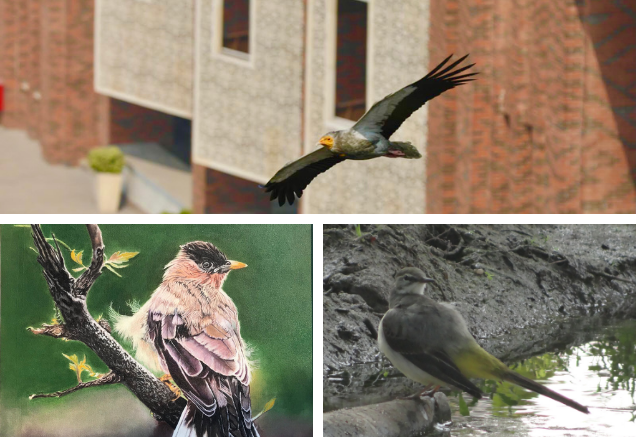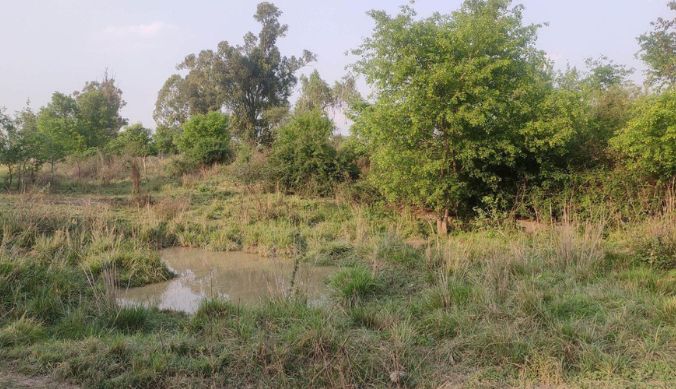The Wildlife in Our Own Backyard
After all, how can we hope to save the polar bears and lions of the world if we do not even know what animals live next door?
Excusing myself under the pretext of visiting the loo, I exited the academic building, keen on finding the culprit responsible for preventing my descent into slumber. I scanned every nook and cranny of the Ashoka lattice design to search for whatever was making the noise.
Then I saw it—a large parakeet with a splash of red on its shoulder.
Any discontent I had instantly evaporated, for I was staring at an Alexandrine parakeet.
The Alexandrine parakeet (Psittacula eupatria) is a large green bird native to the Indian subcontinent and parts of Southeast Asia, getting its name from Alexander the Great. It is believed that he encountered these vibrant birds during his conquests across the region.
I certainly did not expect to see this bird. Until then, I thought the campus only abounded in rose-ringed parakeets. It was a startling reminder that wild creatures persist in our concrete jungles.

***
When we think of wildlife, great tigers and elephants come to mind. We think of grand creatures roaming around distant corners of our planet, braving it out in the harshest ecosystems on Earth. Books and documentaries might showcase wildlife that lives only in far-off lands.
Yet, we often forget that some animals live (and thrive) in human-dominated habitats. These creatures have adapted to the modern world. Buildings and human infrastructure do not seem to quell their numbers. Despite appearing like the most inhospitable place for wildlife, Ashoka harbours a dazzling array of creatures.
But our rhetoric of portraying wildlife as only these animals that live in inaccessible places makes them unrelatable for most people. And that runs against the conservation ethos we need to protect our natural world. More people will champion the cause of wildlife if they can directly relate to it. That starts by identifying the wildlife in our own backyard. After all, how can we hope to save the polar bears and lions of the world if we do not even know what animals live next door?
Take a look at this picture. It looks like something out of the tropical Western Ghats of South India, right?

Wrong.
It was taken just beyond Asawarpur, barely even a kilometre from campus. This small pond in the middle of the agricultural fields is a haven for the local wildlife. How wonderful it would be to sit here all day and see what animals come visiting.
Step outside the confines of the red-bricked campus, and the number of creatures you encounter increases tenfold. The agricultural fields of Sonipat have so many birds that come over from places like Siberia. Let that sink in. These are creatures that have travelled across the globe to our neighbourhood. How cool is that!
Over the last few years, along with some other students, I have been documenting the astonishing bird life in and around the campus. Late last year, we came out with Ashoka’s first-ever fauna guide, cataloguing an astounding 125 species of birds, along with several reptiles and mammals. These are impressive numbers, given the area and habitat our college is in. People scarcely believe that we have so much wildlife.
If you wish to see this fauna guide, please visit Ashoka University’s Sustainability webpage.
***
There are several things university campuses can do to promote a strong ethos around wildlife. By simply planting native fruit-bearing trees, one can drastically improve the presence of birds. Have you ever wondered why the area around Dosai has so many birds?
A small pond with small fish to prevent mosquitoes from breeding will boost local wildlife numbers. The university can allot space in the new campus for this. It does not need to be—a pond 15-20 feet across surrounded by some vegetation should be sufficient.
The university could organise campus nature walks combined with expert talks and field trips to expose students to the wonders of nature. The Mandothi wetlands, 50 km from Ashoka, is a great place to start. What about the trees on campus? Who among the students can accurately identify the trees around campus? We walk past them every day, sometimes studying in their shade. Would it not be wonderful if we knew its basics, like its name? The university could print small placards with the tree’s name (with local and scientific names) and attach them to all the trees across campus. This small step would massively improve the ecological literacy of the students.
***
Another day, I was jogging along the road that leads to TDI when something ahead caught my eye. Hurrying forward, I found a single porcupine quill staring back at me.
Who knew porcupines were found in the fields of Haryana?
It is in these tiny ways that nature whispers to us. They leave these markers everywhere, through the feathers, seeds and now quills scattered along the roads. There is always something left for us to discover in nature. That is an encouraging thought.
Enough with the grand rhetoric. It is time that wildlife, as a term, refers to not only the great tigers of lore but also to the migratory swallow near the university gate, the porcupine in the fields outside, and the parakeets perched at our classroom’s windows.
Study at Ashoka












